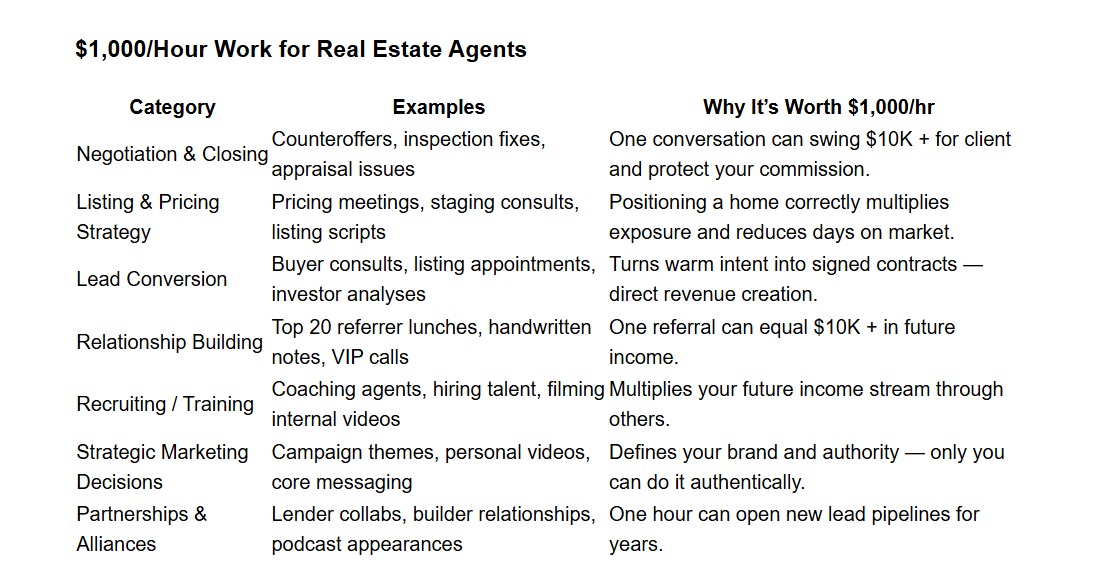
The $10 000-Hour Week — How to Find Leverage in Your Time
Have you ever watched the clock while your business grinds to a halt?
You know the drill: you wake up thinking you’re going to “crush it today,” but by 6 pm you’ve done a dozen tasks, burned out, and still don’t have a new appointment or meaningful progress.
Seriously. You’ve been a whirlwind of activity, it’s suddenly 6pm and you think to yourself, “Where did the day go?”
In Ch. 8 and 9 of 80/20 Sales & Marketing, Perry Marshall invites you to stop being busy and start being leveraged. The goal isn’t a 60-hour week; it’s a $10,000-hour week — the week in which your highest-value actions dominate and the rest get chopped.
📊 Time obeys the 80/20 rule too
Just like 20% of your leads produce 80% of your commissions, 20% of your hours produce 80% of your results. Within that 20%, another 20% create the lion’s share.
If you think about it, you’re only truly “on” for maybe 8–12 hours a week — the ones when you’re booking, negotiating, closing. So why spend the other 28–32 hours answering emails, tweaking flyers, or waiting for door-knocks?
And you know you do it! Stop denying it.
You don’t need more hours; you need better ones.
The difference between a $60,000-year and a $300,000-year isn’t hustle. It’s leverage.
🧰 The “Hour-Value Multiplier”
Perry suggests you track the hourly value of your tasks. Ask: “Is this a $10-hour task? $100-hour? $1,000-hour?”
If it’s a $10-hour task and you’re doing it 30 hours a week, something’s off. You need to shift it, delegate it, or delete it.
✂️ Delegation. Automation. Elimination.
Delegation: If you’re doing it and you’re not the only one who can do it—delegate.
Automation: Set up systems (CRM triggers, email flows, ad templates) so the engine runs while you sleep.
Elimination: What you shouldn’t be doing. The “To-Delete” list. If it doesn’t generate an appointment, it gets axed.
🧭 A Simple Framework for Agents
Block one “$1,000-hour” slot each morning (e.g., 8:30–10 am: listing presentations).
Block a “$100-hour” slot later (e.g., follow-up calls, nurture emails).
Everything else either gets delegated (admin, photo edits) or scheduled once a week (social content bulk).

Think of your week as three concentric circles: your core high-value (center), your mid-value (ring), and everything else (outer ring) that slowly gets stripped out.
💰 $1,000-Per-Hour Work
These are your high-leverage, irreplaceable, money-making activities. They rely on your judgment, persuasion, and expertise — the things no assistant or automation can do 80 percent as well.

💼 $100-Per-Hour Work
This is the support layer — important, but not irreplaceable. These tasks maintain momentum, deepen relationships, and prepare your $1,000-hour moments — but they’re also the first you should delegate or systemize as you grow.

🏁 Your Challenge This Week
Audit your week. Choose one hour this week and track what you actually did. Label it a $10-, $100-, or $1,000-hour.
Delegate down. Identify the 2 tasks you’ll delegate or delete next week. Anything under $100/hr belongs to an assistant, automation, or “to-delete” list.
Protect your core. Schedule your top “move the needle” $1,000-hour for each day ahead.
Elevate weekly. Replace one $100-hour task with a $1,000-hour activity every week.
The agents who grow fastest don’t add hours — they upgrade them.
When you treat every hour like capital, you start earning like an investor instead of an employee.
The clock’s ticking. The $10,000-hour week isn’t about working harder — it’s about working smarter. Time is your most undervalued asset. Treat it like one.

